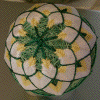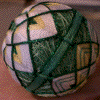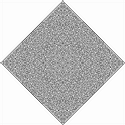You may ask, what is jute? (Or, alternately, Que é a juta?) Well, this entry is devoted to answering all your jute questions.
Jute is a plant from India used to make burlap, twine and a variety of other materials. Production involves fermenting the jute (retting) then separating out, drying, and sorting the fibers. See JM Jute for details and pictures.
The word jute comes from the Bengali jhuto. There are two species of jute: Corchorus ularis (Jute) and Corchorus olitorius (Jew’s mallow). You can see a picture of the jute plant at the Bangladesh Jute Research Institute. They’ve developed a cheap wool substitute, jute yarn. Jute is a big industry in India - the Jute Commissioner even has his own website.
Why jute? Evenweave jute is the base for Arraiolos rugs. In the US, you can get ten-count jute (ten threads per inch) and Persian yarn (a three-ply needlepoint wool thread - Paternayan makes the best one) to approximate the traditional Portuguese materials. Or you can order a kit from Portugal, which is how the whole jute question came up.
The oldest Arraiolos rugs were made with wool on linen, but linen has been out of style for several centuries now. It’s beyond me why Casa dos Tapetes de Arraiolos offers any wool on linen products, or which ones they might be. I have established that my kit (Seteais, the top one in this image) contains jute.
The price may seem like a lot (for Portugal), but it’s cheap compared to, say, buying painted needlepoint canvases and then wool on top of that, plus shipping. The kit is 1 1/2 feet square - not quite a rug, but big for a pillow. It takes a lot of wool to cover 2 1/4 square feet. The real appeal to me, though, is the Seteais pattern itself. Seteais is the most popular Arraiolos design and my favorite as well. It comes from the carpets of the Seteais Hotel outside Sintra, though it can also be seen in the Portuguese Embassy in Washington D.C. Normally it’s laid out in alternating squares, as in this rug. I don’t have a pattern for it.
Now that I’ve bored everyone to tears, I promise to stop rug geeking.


